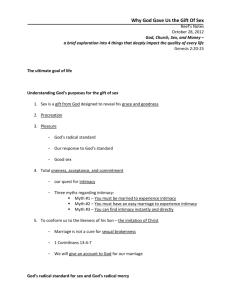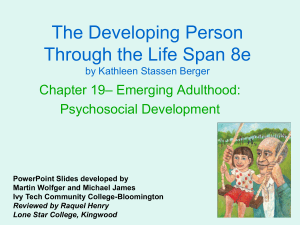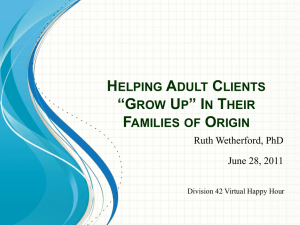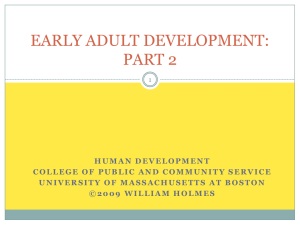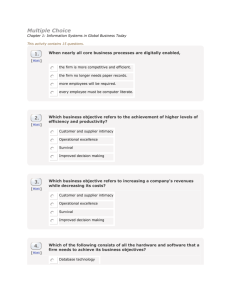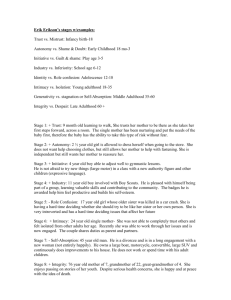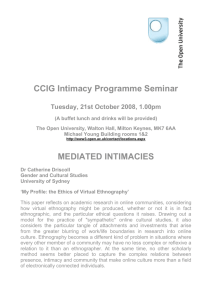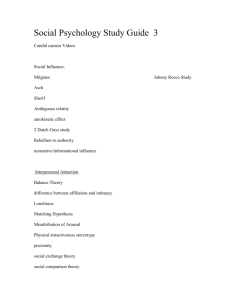chapter 19
advertisement
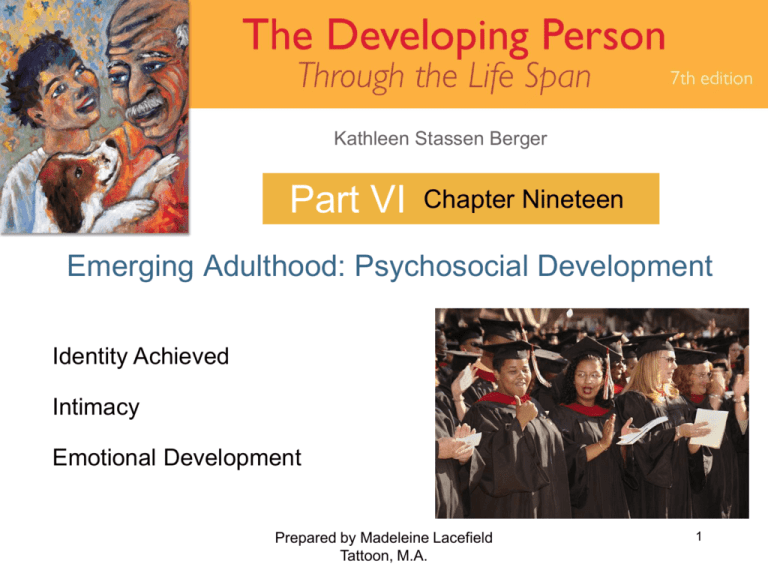
Kathleen Stassen Berger Part VI Chapter Nineteen Emerging Adulthood: Psychosocial Development Identity Achieved Intimacy Emotional Development Prepared by Madeleine Lacefield Tattoon, M.A. 1 Emerging Adulthood: Psychosocial Development “In psychosocial development, even more than in physical or cognitive development, the hallmark of contemporary adult life is diversity.” 2 Identity Achieved • the search for identity begins at puberty, and continues through adulthood • each stage’s crises provides the foundation for each new era… as is evident in the emerging adult 3 Identity Achieved • Ethnic Identity – in the U.S. and Canada 1/2 of the 18 – 25year-olds are either children of immigrant or native-born Americas of African, Asian, Indian, or Latino descent – most individuals identify with very specific ethnic groups, e.g. Vietnamese, Pakistani, or Korean Americans, not simply Asian 4 Identity Achieved • Ethnic Identity – emerging adults meet many more people of other backgrounds – European Americans also understand the importance of their own ethnicity, e.g., Ukrainian Catholic or Russian Jewish 5 Identity Achieved • Ethnic Identity – everyone struggles to forge an identify, but immigrants combining their parent’s past and their future new social context often have conflicts 6 Identity Achieved • Ethnic Identity – choices affect language, manners, romance, employment, neighborhood, religion, clothing, and values 7 Identity Achieved • Ethnic Identity – is reciprocal, both a personal choice and a response to others – it depends on context and therefore changes with time and circumstances – it is multifaceted… emerging adults choose some attributes and rejects others 8 Identity Achieved • Ethnic Identity – the changing contexts of life require ethnic identity to be reestablished at each phase… with one identity in adolescence, another in emerging adulthood 9 Identity Achieved • Vocational Identity – is a part of growing up – college is considered an important step towards a career – a correlation between college education and income has been evident… few unskilled jobs have been created in the 21st century 10 Intimacy – Intimacy versus Isolation • the sixth of Erikson’s eight stages • adults seek someone with whom to share their lives in an enduring and selfsacrificing commitment • without such commitment they risk profound aloneness and isolation 11 Intimacy • Friendship – friends defend against stress and provide joy throughout life – friends are chosen for understanding, tolerance, loyalty, affection, humor – friends are earned; they choose us, unlike family 12 Intimacy • gateway to attraction – physical attractiveness (even in platonic same-sex relationships) – apparent availability (willingness to talk, to do things together) – frequent exposure – absence of exclusion criteria (no unacceptable characteristics) 13 Intimacy • Gender and Friendship – men and women have the same friendship needs – humans seek intimacy, lifelong – men tend to share activities and interests – women have friendships that are more intimate and emotional 14 Intimacy • Gender and Friendship – more men than women are homophobic – male-female differences may be cultural and seem to be less stereotyped among contemporary emerging adults – cross-sex friendships have potential problems 15 Intimacy • Romance and Relationships – couples are marrying later and divorcing more often than earlier cohorts – marriage is being postponed, not abandoned 16 Intimacy • Romance and Relationships – the relationship between love and marriage depends on the culture • In 1/3 of all nations, people fall in love and then decide to marry, with the young man asking the young woman • North Americans and Europeans expect to fall in love several times but not to marry until they are financially and emotionally independent 17 Intimacy • The Dimensions of Love – love is not a simple emotion – not something universally recognized as the glue that holds a relationship together 18 Intimacy • The Dimensions of Love – Sternberg described three distinct aspects of love • passion • intimacy • commitment 19 Intimacy • Cohabitation – an arrangement in which a man and a women live together in committed sexual relationship but are not formally married – more than ½ of all emerging adults cohabit during emerging adulthood 20 Intimacy – Cohabitation • many people think that living together is a good prelude for marriage; researchers suggest they are mistaken • living together before marriage does not preclude problems that might arise after a wedding 21 Intimacy • What Makes Relationships Work – marriage is not what it once was… a legal and religious arrangement that couple sought for sexual expression – most adults aged 20 to 30 are not yet married – compared to any year in the past, fewer adults are married (58%) and more are divorced – the divorce rate is ½ the marriage rate 22 Intimacy • What Makes Relationships Work – homogamy • marriage between individuals who tend to be similar with respect to such variables as attitudes, interest, goals, socioeconomic status, religion, ethnic background, and local origin – heterogamy • marriage between individuals who tend to be dissimilar with respect to such variables as attitudes, interest, goals, socioeconomic status, religion, ethnic background, and local origin 23 Intimacy • What Makes Relationships Work – social homogamy • the similarity of a couple’s leisure interests and role preferences – social exchange theory • the view that social behavior is a process of exchange aimed at maximizing the benefits one receives and minimizing the costs one pays 24 Intimacy • Domestic Violence: – common couple violence • a form of abuse in which one or both partners of a couple engage in outbursts of verbal and physical attacks… also called situational couple violence – intimate terrorism • spouse abuse in which, most often, the husband uses violent methods of accelerating intensity to isolate, degrade, and punish the wife 25 Intimacy • Family Connections – “It is hard to overestimate the importance of the family at any time of the life span.” – families are “our most important individual support system,” a “problemsolving system” 26 Emotional Development • during emerging adulthood people are at their peak: – strength – sexual impulse – health – cognitive growth 27 Emotional Development • Well-Being – allows emerging adults to • • • • • • • learn explore make friends find lovers take whatever job journey take risks 28 Emotional Development • positive emotions increase when adults have close relationships with – – – – friends lovers parents undergo successful transitions • leaving home • graduating from college • securing a good job 29 Emotional Development • Well-Being – some of the depression and anxieties of adolescence lift when young people leave their high schools and distance themselves from dysfunctional families 30 Emotional Development • Psychopathology – not all young adults benefit from independence… some adults have too many choices and too little guidance – diathesis-stress model • the view that mental disorders, such as schizophrenia, are produced by the interaction of a genetic vulnerability (the diathesis) with stressful environmental factors and life events 31 Emotional Development • Substance Abuse Disorders – emerging adulthood is the most common time for substance abuse – 1 in 8 is addicted before age 27 – substance abuse can be a common interest for friends and romantic partners – most sufferers manage to put an end to abuse without professional counseling 32 Emotional Development • Mood Disorders – before age 30, 8% of U.S. residents suffer from a mood disorder – major depression is the most common – may be biochemical… imbalances in neurotransmitters and hormones (can also be triggered by a stressor 33 Emotional Development • Anxiety Disorders – ¼ of U.S. residents below the age of 25, including • post-traumatic stress disorder (PTSD) • obsessive-compulsive disorder (OCD) • panic attacks – age and genetic vulnerability shape the symptoms of anxiety disorders 34 Emotional Development • Schizophrenia – 1% of all adults experience at least one episode of schizophrenia – partly genetic – malnutrition when the brain is developing – symptoms typically begin in adolescence • diagnosis is most common from ages 18-24 35 Emotional Development • Continuity and Discontinuity – most emerging adults have strengths as well as liabilities – many overcome anxieties, substance abuse, etc… through “self-righting,” social support and ongoing maturation 36
